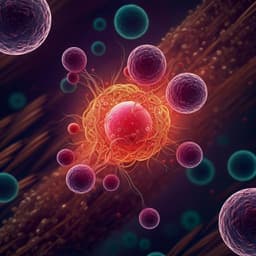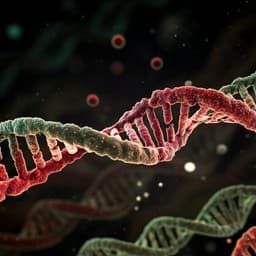
Food Science and Technology
Less animal protein and more whole grain in US school lunches could greatly reduce environmental impacts
A. L. Stern, N. T. Blackstone, et al.
This groundbreaking research by Alexandra L. Stern, Nicole Tichenor Blackstone, Christina D. Economos, and Timothy S. Griffin reveals the significant environmental impacts of lunches in the National School Lunch Program. Discover how adjusting meat consumption and increasing whole grain requirements could pave the way for a more sustainable food system in schools.
~3 min • Beginner • English
Introduction
High-income countries must shift dietary patterns to reduce environmental burdens from food systems. Government programs, including the U.S. National School Lunch Program (NSLP), are key levers due to their scale and standards. The NSLP had a $14B annual budget and served nearly 40% of U.S. children daily in 2019, positioning it to influence children’s diets and environmental impacts. While NSLP is routinely assessed for cost and nutrition, aggregate environmental impacts of its foods were unknown. Prior European studies evaluated school meal impacts, often focusing on greenhouse gas emissions, and U.S. studies evaluated impacts of adult diets and guidelines, generally finding lower impacts with fewer animal products. There is a need for LCA data tailored to U.S. school meals across multiple impact categories. This study aimed to: (1) collate LCIs for NSLP foods; (2) estimate agricultural production impacts of lunches; (3) examine impact distributions across lunches and contributions by quintiles and food groups; and (4) analyze lunch composition by impact quintile to inform policy.
Literature Review
The paper situates its work within research showing that diets with fewer animal products and more whole grains and legumes are lower impact. European school systems have assessed lunch impacts (e.g., England, Spain, Finland, Italy) primarily on GWP, highlighting cross-context variability. U.S.-focused studies on average diets and the Dietary Guidelines similarly find meat and dairy as major impact drivers and fruits/vegetables as contributors to water use. Findings from Rose et al. (2019) report low-GHGE diets with about twice the whole grains, legumes, nuts/seeds and less than half the animal protein content compared with high-GHGE diets. Poore and Nemecek (2018) and others consistently identify beef as a dominant driver of GWP, land use, and eutrophication. Recent work emphasizes the importance of water scarcity metrics and variability in water footprints across foods, including nuts and poultry. The study aligns with this body of evidence but fills a gap by focusing specifically on U.S. NSLP lunches and multiple impact categories beyond GWP.
Methodology
Data sources: Lunch composition data came from the USDA School Nutrition and Meal Cost Study (SNMCS) for the 2014–2015 school year, a nationally representative sample of 1,207 schools capturing over 2.2 million lunches and >1,300 unique food items. Schools reported types and quantities of foods served over a school week; menu items were linked to FNDDS 2011–2012 codes for nutrient composition.
Environmental inventories: Life cycle inventories (LCIs) were sourced from ecoinvent 3.6 and one external study. Because ecoinvent lacks prepared/mixed dishes, recipes from EPA’s Food Commodities Intake Database (FCID) were used to disaggregate foods into 563 commodities and translate commodity impacts to prepared foods.
LCI selection and proxying: A hierarchical decision tree prioritized LCIs with U.S. geography due to Buy American provisions; if unavailable, LCIs from top importing countries (per USDA FAS GATS) or global averages were used. When no exact LCIs existed, proxies were assigned based on similarity in production practices, climate, and biology; proxy groups followed Heller et al. (2018) where applicable. LCIs for milling and oil extraction (e.g., wheat flour, maize flour, rapeseed oil, soybean oil) were modified to reflect U.S. energy mixes and to represent other flours/oils by substituting primary inputs (e.g., barley for wheat). System boundaries were cradle-to-farm gate, except flours/oils to processor gate. Functional unit: 1 kg commodity.
Impact assessment: ReCiPe 2016 Midpoint Hierarchical in openLCA 1.10.3 was used to calculate impacts for five categories pertinent to agriculture: global warming potential (GWP), land use, water consumption, freshwater eutrophication (g P eq), and marine eutrophication (g N eq). Eighteen categories were computed but only five reported.
Conversions/recipe mapping: SNMCS quantities were as-served; conversion factors (Food Intakes Converted to Retail Commodities Database and other sources) adjusted for inedible parts, preparation, and cooking losses (applied only to commodities indicated as cooked in FCID recipes). For each food, impacts were computed by multiplying commodity impacts by the commodity proportion in the recipe and summing to obtain impacts per 100 g as served.
Aggregation and normalization: Using SNMCS survey design parameters, average lunch impacts were calculated including any potentially wasted portion (excluding end-of-life waste management). To compare lunches, impacts and composition were normalized to the average energy served (620 kcal). Impacts were also expressed per 1000 kcal.
Quintile analysis and statistics: For each impact category, lunches were divided into quintiles using 20th, 40th, 60th, and 80th percentiles (e.g., GWP range 0.24–9.9 kg CO2 eq; cutoffs 0.77, 0.99, 1.4, 2.1 kg CO2 eq). Composition differences between lunches in the 1st vs. 5th quintiles across all impact categories were compared using two-sample t-tests (energy-adjusted). Analyses were conducted in R (RStudio 1.2.1335; R 4.0.3).
Uncertainty: Robustness was assessed by comparing commodity impact rankings across different methods, software, and databases; rankings of climate change, marine eutrophication, and land use were most consistent, water consumption least consistent. The ten most common commodities (milk, apple, wheat, chicken, potato, tomato, beef, orange, carrot, soybean oil) accounted for >65% of total mass.
Key Findings
- Average impacts per lunch (mean ± SE; ~620 kcal per lunch): GWP 1.5 ± 0.03 kg CO2 eq; Land use 1.8 ± 0.03 m2a crop eq; Water consumption 0.055 ± 0.00066 m3; Marine eutrophication 3.1 ± 0.049 g N eq; Freshwater eutrophication 0.24 ± 0.0016 g P eq. Per 1000 kcal: GWP 2.4 ± 0.043 kg CO2 eq; Land use 2.9 ± 0.055 m2a crop eq; Water 0.089 ± 0.0011 m3; Marine eutrophication 5.0 ± 0.08 g N eq; Freshwater eutrophication 0.39 ± 0.0027 g P eq.
- Impact distribution: For all categories except water consumption and freshwater eutrophication, 5th-quintile lunches contributed about 40% of total impacts; contributions from 4th and 5th quintiles dominated totals. GWP across lunches ranged 0.24–9.9 kg CO2 eq; quintile cutoffs at 0.77, 0.99, 1.4, 2.1 kg CO2 eq.
- High vs. low impact lunches: Approximately 62,000 lunches were in the 1st quintile for all categories (low impact) and ~38,000 in the 5th quintile for all (high impact). Energy-adjusted comparisons showed low-impact lunches had more dairy (especially cheese), whole grains, seafood, and nuts/seeds; high-impact lunches had more fruit/fruit juice, meat (beef, pork, poultry), and starchy vegetables. Notable differences (energy-adjusted averages): protein foods 0.69 vs 1.72 oz eq (low vs high); beef/pork 0.00 vs 1.02 oz eq; whole grains 1.43 vs 1.16 oz eq; nuts/seeds 0.19 vs 0.01 oz eq; dairy 1.58 vs 1.03 cup eq; fruit juice 0.05 vs 0.17 cup eq; starchy vegetables 0.11 vs 0.20 cup eq. High-impact lunches had ~1 oz eq more meat, including ~1 oz eq beef.
- Food group contributions (by mass vs impacts): Meat was 8% of total mass but contributed most to impacts (28–67% across categories). Beef (2% of mass) accounted for roughly half of GWP, land use, and marine eutrophication. Dairy was the second-largest contributor to most categories (17–29%), except water consumption (7%). Fruits (27%) and vegetables (14%) substantially contributed to water consumption; poultry alone contributed 19% of water consumption due to irrigated feed reliance and high serving frequency.
- Correlations: Lunch composition in 5th quintiles for land use, marine eutrophication, and GWP was relatively consistent; these impact categories were strongly positively correlated (r ≥ 0.99, p < 0.05).
- Proxy LCIs: Although over half of FCID commodities required proxies, proxies contributed minimally to total impacts (<12% across categories; e.g., total diet proxies: 2.7% GWP, 2.8% land use, 11.6% water consumption, 3.1% marine eutrophication, 6.3% freshwater eutrophication).
- Water consumption drivers: Meat (28%), fruit (27%), vegetables (14%) were major contributors, largely from irrigation; 73% of chicken’s water consumption derived from irrigation of feed crops. Commonly served irrigated items included apples, oranges/juice, grapes, potatoes, tomatoes, carrots, iceberg lettuce.
- Variability within categories: Nuts/seeds contributed <1% overall due to low volume and generally low impacts, but tree nuts (almonds, cashews) required >6× the water of peanuts/sunflower/sesame per kg.
Discussion
The study provides the first baseline environmental impact assessment of U.S. NSLP lunches, directly addressing the need for program-specific, multi-category LCA data. Findings confirm prior literature: animal-source foods, especially beef, dominate GWP, land use, and eutrophication impacts; fruits and vegetables contribute substantially to water consumption. The disproportionate contribution of the highest-impact lunches (~20% of lunches producing ~40% of impacts) indicates that targeted policy changes focused on these menus could yield large reductions.
Policy relevance: Limiting beef servings or frequency and increasing whole grain requirements could substantially reduce impacts while aligning with nutritional goals. Given dairy’s role as a meat alternative, care must be taken because cheese carries higher impacts than plant-based proteins and has potential nutrition concerns (sodium, saturated fat). Water-related tradeoffs arise with fruit: lunches with highest water consumption included more fruit, but differences in fruit quantities between high and low water-impact lunches were small (~0.1 cup eq). Poultry’s water intensity in school lunch reflects serving frequency and irrigated feed use; strategies could include diversifying protein sources (seafood from sustainable fisheries, legumes, nuts/seeds with attention to water footprints) and emphasizing whole grains.
Implementation considerations: Successful changes require alignment with cost, access, infrastructure, and student acceptance. Financial incentives, procurement standards, and pairing menu changes with food systems and nutrition education can improve uptake and reduce unintended consequences (e.g., food waste). There are opportunities to align NSLP standards with USDA conservation initiatives (e.g., promoting small grains, nuts, seeds from conservation rotations), potentially creating market pull for environmentally beneficial practices.
The strong correlation among GWP, land use, and marine eutrophication suggests that interventions reducing beef could concurrently reduce multiple impact categories. However, water outcomes may require separate consideration due to different drivers (irrigation of produce and feed). Overall, the work supports integrated, pragmatic policy approaches that prioritize high-impact lunches, limit beef, and expand whole grains and lower-impact protein options, supported by education and procurement strategies.
Conclusion
This study quantified average environmental impacts of U.S. NSLP lunches and showed that a small subset of high-impact lunches contributes disproportionately to total impacts. Meat—particularly beef—and dairy dominated most impact categories, while fruits and vegetables, along with poultry, drove water consumption. Results suggest two high-leverage strategies: limit beef servings/frequency and increase whole grain requirements. Near-term progress could be achieved via financial incentives and program implementation (e.g., procurement preferences, education interventions) while broader nutrition standard updates proceed. Future research should: integrate water scarcity metrics; extend system boundaries beyond farm/processor gate to include downstream stages; refine guidance on specific seafood, nut/seed, and grain types and production practices; assess cost and acceptance implications; and develop implementation science for kid-friendly recipes and logistics to avoid unintended consequences such as food waste.
Limitations
- Water metric: Used water consumption rather than water scarcity; water scarcity footprints for U.S. foods are now available and should be integrated in future analyses.
- System boundary: Impacts assessed to farm or processor gate; downstream stages (distribution, preparation, end-of-life, food waste management) were not included.
- Beef sourcing: Did not account for beef originating from dairy systems; dairy-derived beef can have substantially lower impacts (up to ~3× lower), and NSLP may rely more on dairy beef due to surplus foods, potentially biasing impacts upward.
- LCI coverage: Many FCID commodities required proxy LCIs; although proxy contributions to total impacts were small, they introduce uncertainty.
- Water impact variability: Water consumption estimates had less consistent rankings across methods relative to other categories, indicating higher uncertainty.
- Food waste: Potentially wasted portions were included in served amounts, but end-of-life waste impacts were excluded.
- Prepared food LCIs: Lack of LCIs for combination dishes necessitated recipe-based disaggregation, which may not capture all processing nuances.
Related Publications
Explore these studies to deepen your understanding of the subject.







